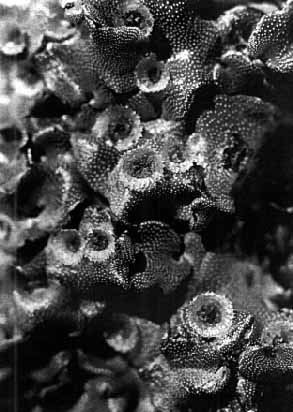
As we approach the next millennium, the goal of the American Bryological and Lichenological Society and its associated section of the Botanical Society of America will continue to be fostering the scientific study of mosses, liverworts, hornworts, and lichens to achieve understanding of their often unique structural and physiological adaptations and ecological roles. Expansion of research in four primary areas is considered central
 |
|---|
| The liverwort Marchantia with gemma cups. Courtesy: D.S. Neuberger. |
Tantamount to these research goals is the need to improve the dissemination of bryological and lichenological information to the academic community and the public at large. Since few educational institutions have professional bryologists or lichenologists on staff, the American Bryological and Lichenological Society needs to organize teaching workshops and distribute sets of teaching materials that can be used in general plant biology programs. Regional bryological and lichenological forays for amateur naturalists should be encouraged, advertised, and supported. The American Bryological and Lichenological Society should continue to participate in national programs like the Flora of North America project and the National Biological Survey program. The American Bryological and Lichenological Society's interests need to be represented in such national groups as the American Association for the Advancement of Science and the American Institute of Biological Sciences.
During the past 40 years, there has been a notable shift in professional positions in bryology and lichenology from doctoral degree-granting institutions to nondegree centers. This trend must be reversed if the discipline is to have a viable future. Improved research funding and incentives to support graduate training in bryology and lichenology are essential components for improving students' marketability. Students must be broadly trained in their botanical subdiscipline and should be encouraged to apply modern techniques to their research questions. Bryology and lichenology students must be able to compete for jobs as physiologists, ecologists, geneticists, cell biologists, anatomists, and systematists.
As a group, bryologists and lichenologists need to be more aggressive and innovative in their funding efforts and more vocal as to the impact of their studies on science and society. To enhance funding potential, more interdisciplinary investigations should be considered. Major national funding agencies must likewise recognize that bryophytes and lichens constitute a significant element of the natural world and that their study is worthy of support.




